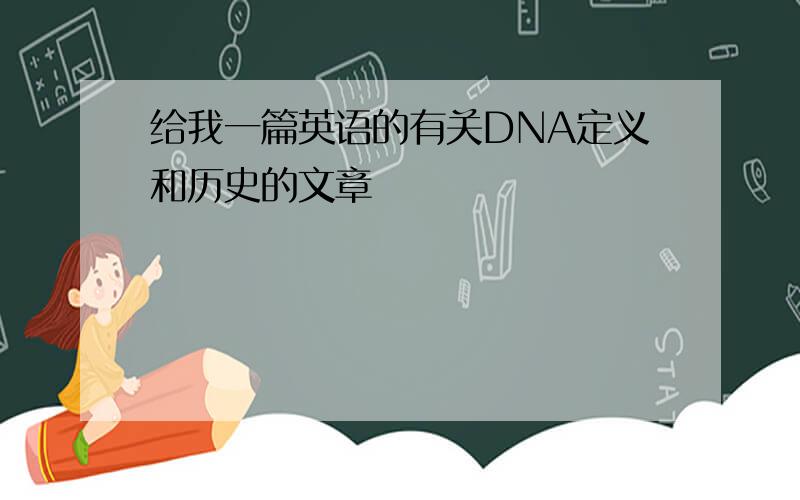给我一篇英语的有关DNA定义和历史的文章
来源:学生作业帮 编辑:神马作文网作业帮 分类:英语作业 时间:2024/11/19 04:12:03
给我一篇英语的有关DNA定义和历史的文章

DNA is basically a long molecule that contains coded instructions for the cells. Everything the cells do is coded somehow in DNA - which cells should grow and when, which cells should die and when, which cells should make hair and what color it should be. Our DNA is inherited from our parents. We resemble our parents simply because our bodies were formed using DNA to guide the process - the DNA we inherited from them.
We may resemble our parents, but we are never exactly like them. This is because each child gets only some of the DNA each parent carries. About half our DNA comes from our mother, and half comes from our father. Which pieces we get is basically random, and each child gets a different subset of the parents' DNA. Thus, siblings may have the same parents, but they usually do not have exactly the same DNA (except for identical twins).
DNA is a long molecule, like a chain, where the links of the chain are pieces called nucleotides (sometimes also called 'bases'). There are four different types of nucleotides in DNA which we'll call 'A', 'G', 'C' and 'T'. These four are all that's necessary to write a code that describes our entire body plan. Sounds too simple? Keep in mind that Morse Code uses only four symbols (dot, dash, short spaces and long spaces), and you could spell out entire encyclopedias of knowlege with that simple code!
DNA chains are made by connecting those nucleotides together via chemical bonds. At right is a diagram showing four nucleotides connected to form an oligonucleotide, in this case an RNA oligo (note that it has '-OH' at the lower right corner of each nucleotide, as opposed to the '-H' in DNA). I've left off the bases, for simplicity's sake. You can see the sugar rings linked together with phosphate bridges. This is a "single-stranded" nucleic acid.
Double-stranded DNA is simply two chains of single- stranded DNA, positioned so their "bases" can interact with each other. At left is a cartoon depiction of double-stranded DNA. The sugar-and-phosphate 'backbone' is depicted in red, and the bases are depicted in blue.
Importantly, the two strands travel in opposite directions; hence the structure is said to be "anti-parallel".
The bases in the middle "pair up" with bases on the opposite strand, so that a type 'A' nucleotide is always opposite a type 'T', and 'G' is opposite 'C'. The attraction between the paired nucleotides is fairly weak, but when there is a whole string of them, it adds up to enough strength to hold the strands together.
We may resemble our parents, but we are never exactly like them. This is because each child gets only some of the DNA each parent carries. About half our DNA comes from our mother, and half comes from our father. Which pieces we get is basically random, and each child gets a different subset of the parents' DNA. Thus, siblings may have the same parents, but they usually do not have exactly the same DNA (except for identical twins).
DNA is a long molecule, like a chain, where the links of the chain are pieces called nucleotides (sometimes also called 'bases'). There are four different types of nucleotides in DNA which we'll call 'A', 'G', 'C' and 'T'. These four are all that's necessary to write a code that describes our entire body plan. Sounds too simple? Keep in mind that Morse Code uses only four symbols (dot, dash, short spaces and long spaces), and you could spell out entire encyclopedias of knowlege with that simple code!
DNA chains are made by connecting those nucleotides together via chemical bonds. At right is a diagram showing four nucleotides connected to form an oligonucleotide, in this case an RNA oligo (note that it has '-OH' at the lower right corner of each nucleotide, as opposed to the '-H' in DNA). I've left off the bases, for simplicity's sake. You can see the sugar rings linked together with phosphate bridges. This is a "single-stranded" nucleic acid.
Double-stranded DNA is simply two chains of single- stranded DNA, positioned so their "bases" can interact with each other. At left is a cartoon depiction of double-stranded DNA. The sugar-and-phosphate 'backbone' is depicted in red, and the bases are depicted in blue.
Importantly, the two strands travel in opposite directions; hence the structure is said to be "anti-parallel".
The bases in the middle "pair up" with bases on the opposite strand, so that a type 'A' nucleotide is always opposite a type 'T', and 'G' is opposite 'C'. The attraction between the paired nucleotides is fairly weak, but when there is a whole string of them, it adds up to enough strength to hold the strands together.